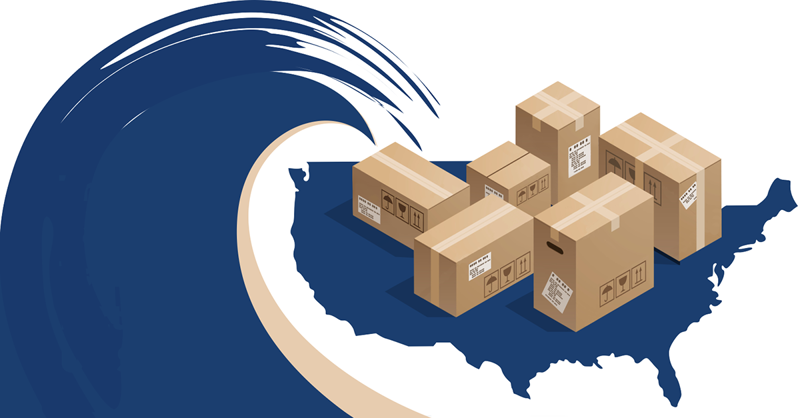With the democratization of eCommerce, global parcel shipping is growing wildly, overwhelming customs and set to raise delivery costs.
You’ve seen the ads on your Facebook or Instagram account — the $13 watch, the $3 wallet, the $15 “18K GOLD DIAMOND Width 1.4cm Length 21cm” — each and every one promising 60 to 70 percent off, sometimes more. One easy tap on the ad brings you to a website where you can see more of the company’s products and another few taps will soon have that $13 watch on its way to your house or office. It’s easy, and you can do it from the comfort of your smartphone.
Nearly as easy? Setting up the online store to sell that watch.
The democratization of eCommerce
“All these sites use a platform called Shopify, which is like the WordPress or Blogger of eCommerce, enabling completely turnkey online stores,” a story in The Atlantic explained. “Now, it has over 500,000 merchants, a number that’s grown 74 percent per year over the last five years. On the big shopping days around Thanksgiving, they were doing $1 million in transactions per minute.”
That watch? It’s coming from another vendor. The online store you ordered from doesn’t even have inventory, but rather relies on Alibaba company AliExpress to ship direct from where it was manufactured to the consumer’s door, The Atlantic story explained. One tiny parcel, shipped all the way from China.
Well, one parcel in a sea of billions. According to a report by Pitney Bowes, “parcel volume has grown from 44 billion parcels in 2014 to 65 billion in 2016, and the increase in growth shows no signs of slowing down, with the Index estimating parcel growth will continue to rise at a rate of 17 to 28 percent each year between 2017 and 2021.”
Customs conundrums and customer complaints
While it may be easy to set up an eCommerce store, and even more easy to order online, delivering parcels across borders is complicated. Customs clearance, duties, and taxes and so on are all different for each border, and all those small shipments are overwhelming customs. Parcels often get tied up at customs, delaying delivery, and upsetting the customer who is, let’s be honest, impatiently waiting for their order.
While the kid (probably) that’s selling $13 watches from the comfort of his parents’ basement could care less (probably) about customer delivery satisfaction, there are many legitimate retailers that do.
In a recent post on Talking Logistics, Adrian Gonzalez discusses the “messy reality” of it all. “Many consumers are not loving the cross-border eCommerce experience, and most of the issues are not with the buying part of the process, but with customs clearance and final delivery. In short, when it comes to cross-border eCommerce, the biggest challenge online retailers and its logistics service providers face today is answering the two most common questions consumers ask after placing an order: Where is my shipment? When will I receive it?”
Governments want their money (surprise!)
On top of everything, industry experts such as Chris Jones, Executive Vice President, Marketing and Services at Descartes, are also “expecting governments to adjust import policies to close on missed revenue and to shift the burden of enforcement to supply chain partners.”
The traditional import model completely changes with a direct-to-customer international eCommerce model, explained Jones in a guest commentary. “Those electronic goods are bought on a website in China or a different country and shipped individually to the end customer. The distributor/retailer goes away. Instead of an ocean carrier and a forwarder, goods come through an express carrier directly to the buyer who the government doesn’t really know. Depending upon the country and the express carrier, the duty is not declared, or properly declared, or the value of the goods is considered to be so low that no duty applies, or the carrier isn’t collecting it.”
Governments are going to want their money, he predicts, and when they begin to implement new policies, that’s going to change the global eCommerce landscape and, among other effects, raise delivery costs.
The cross-border delivery race is on
Moreover, a recent piece in The Economist points to the United States Postal Service subsidizing the rise of eCommerce by “systematically underpricing the cost of parcel deliveries.” That also looks to change, especially in light of USPS owing $34 billion in defaulted worker benefits. “If the post office introduces reforms, as some politicians are now asking, parcel delivery will become more costly.”
Consumers will have none of that higher cost nonsense, however. According to The Economist, DHL estimates “that 15 percent of all eCommerce sales already move from one country to another. By 2020 it expects that share to exceed 20 percent as customers seek lower prices and a broader selection. The big carriers are keen to capture that business. In 2014 FedEx bought a company called Bongo that specializes in cross-border deliveries, to help customers with duties and protect them from fraud.”
And, as we wrote last week, Moller-Maersk is looking to position itself as an inland, last-mile option, in addition to partnering with IBM to step up its data game.
The large players are getting creative and taking chances, placing bets on technology, and partnering with companies that will help them get more control and visibility over shipments. To survive the global growth of parcel shipping, we’re all probably going to have to take that approach.
